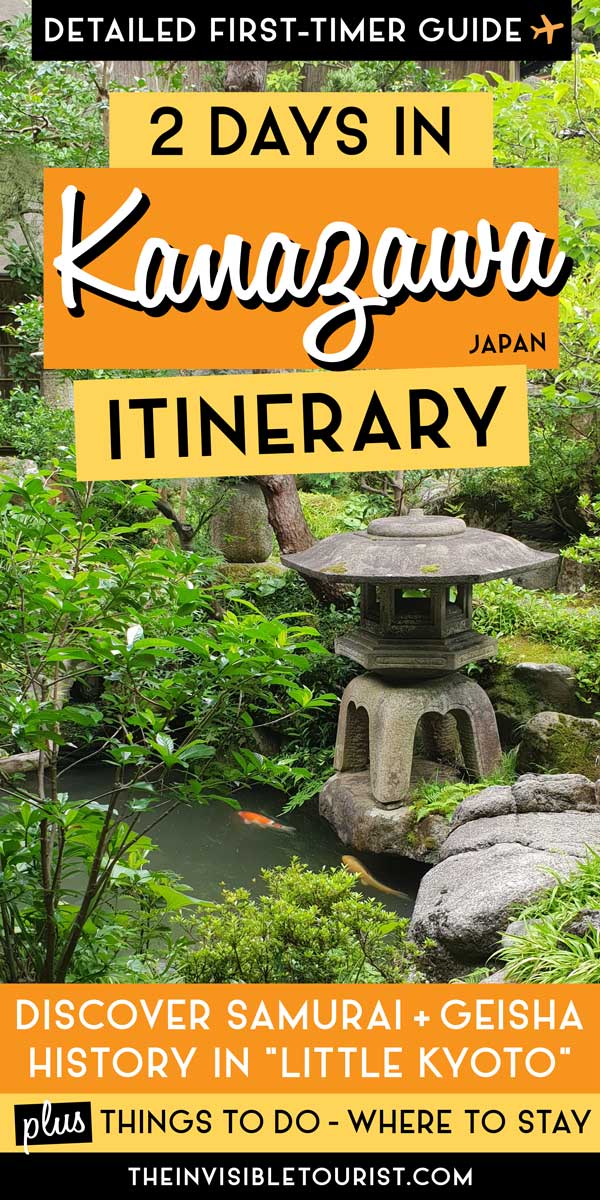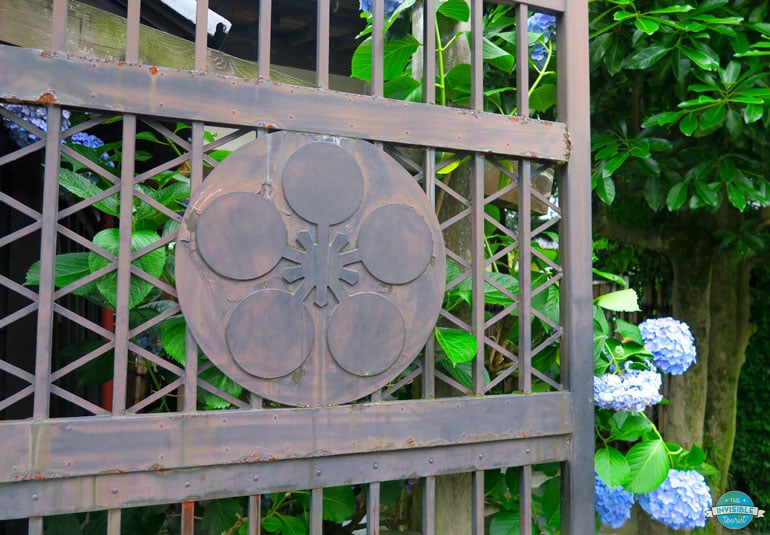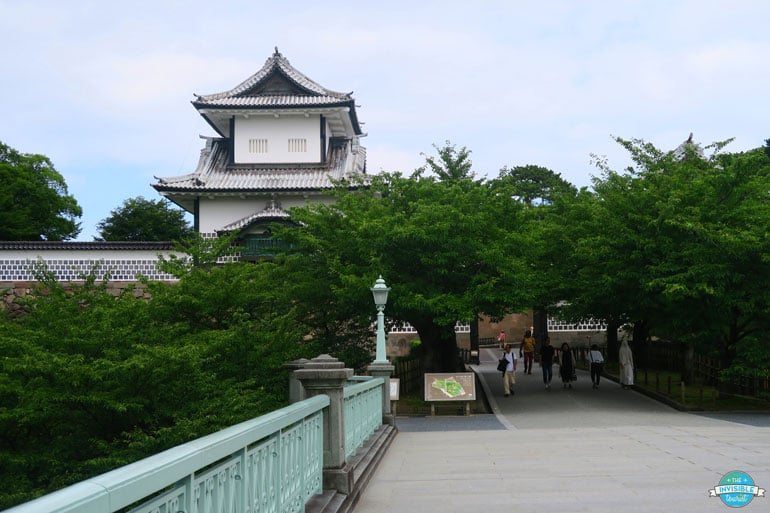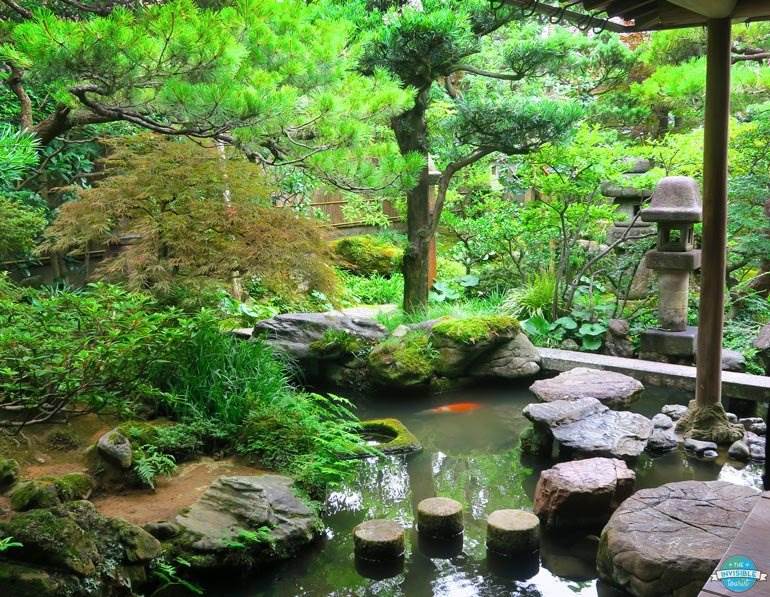2 Days in Kanazawa Itinerary: Uncover Treasures of “Little Kyoto”
What should you add to a 2 day Kanazawa itinerary? Is it Kanazawa really worth visiting? Turns out, there is more here than one might think.
With traditional wooden townhouses, intriguing tales of geisha, remnants of ruling samurai classes and beautifully preserved neighbourhoods, Kanazawa 金沢 is usually dubbed as the “Little Kyoto” of Japan. It’s high on my list of places you should visit in Japan off the beaten track, and for good reason!
Whether Kyoto has left a lasting impression on your heart and you’re eager to explore similar cities, or you’re hoping to visit for the first time, Kanazawa yields the ability to evoke old-world nostalgia and charm, whilst also embracing the contemporary.

Kyoto and Kanazawa have several similarities, but what’s one thing the latter is missing? Huge crowds! As a cultural capital of Japan, Kanazawa is home to one of the country’s top gardens, an impenetrable castle, a fascinating ninja temple, Japanese cultural activities, and even a swimming pool where it’s possible to get beneath the water without getting soaked.
If you’re wondering what to do in Kanazawa in 2 days, read on for more!
This post contains affiliate links, at no extra cost to you. I may earn a small commission if you click through and make a purchase.

Best things to do in Kanazawa in 2 days itinerary
Before jumping into the 2 day itinerary for Kanazawa, here’s one thing that surprised me a little. An important thing to note is unlike some Japanese cities where there is a central area condensed with most of the attractions, the main sights in Kanazawa are quite spread out in different neighbourhoods.
There is also no metro, the only train station being JR Kanazawa which connects to other major cities. Oftentimes walking can be quite far between attractions and hotels, so taking the local Kanazawa loop bus or taxi can be a good idea to have up your sleeve if needed.
TIP: The Hokutetsu loop bus runs every 15 mins around the city, stopping off at the popular attractions. Have some spare change ready as your IC card (Suica card) and Japan Rail Pass are not valid on these buses. Cost: 200 JPY flat fare per ride for getting around the city, or 800 JPY for a 1 day pass. More info here.
However if you’re not in a rush and enjoy upping your step count, walking is the perfect way to get around as Kanazawa is relatively flat. With that said, let’s begin the Kanazawa itinerary!
DAY 1: Admiring craftsmanship & local foods
Wondering what to do in Kanazawa Japan? On the first day of this Kanazawa itinerary, we’ll get our bearings in the city and become acquainted with an underrated highlight that is sure to astonish you!
Admire the grand Tsuzumi-mon Gate
You can’t miss the giant Tsuzumi-mon Gate when exiting JR Kanazawa Station on its south side. Two brown pillars depicting intertwining strings of tsuzumi (traditional Japanese drums) take the form of an oversized torii (gate at the entrance to Shinto shrines) to represent the rich arts culture of the city.
Historically, feudal lords of Kanazawa would invite the highest skilled artisans from Kyoto and Edo (now Tokyo) and commission handicrafts such as kimono, lacquerware and Kanazawa gold leaf.
In 2009, the city of Kanazawa was assigned as a UNESCO Creative City of Crafts and Folk Arts. This means the city has a commitment to maintaining traditional techniques in crafts, promoting craft and creative tourism. The Tsuzumi-mon Gate is a fitting tribute to this!

Pay attention to the Water Fountain Clock
While you’re at the station, admire the Water Fountain Clock that transitions into the time, English and Japanese spellings of Kanazawa from tiny water spouts. It’s pretty unique, and easy to miss if you’re not paying attention!
Gobble your way through Ōmichō Ichiba
Skipped enjoying your first meal at Kanazawa Station? Then head to Ōmichō Ichiba 近江町市場 for a bite to eat. It’s about 15mins walk from the station. This shōtengai (undercover pedestrian shopping street/market) has been the top seafood market in Ishikawa Prefecture since the early 19th century.
With over 200 shops and stalls featuring all kinds of the freshest seafood and produce delivered daily, you’ll also discover little restaurants popular with locals.
NOTE: Some of the stalls are closed on Wednesdays and Sundays, and the overall market closes by 5pm daily.
From Ōmichō Ichiba, follow Hyakumangoku-dori south to check out Kanazawa’s version of a “scramble” crossing. This is the place for a spot of shopping in department stores, international designer brands, or enjoying nightlife by the neon signs in the many karaoke bars, pubs, restaurants, eateries and more in narrow laneways.

Be blown away by ninja trickery at Myouru-ji Temple
Now for one of the underrated things to do in Kanazawa! If time permits, an absolute highlight of my visit was Myouru-ji Temple 妙立寺. Nicknamed Ninja-dera (“Ninja Temple”), this fascinating structure was never actually associated with ninjas but named so for dozens of secret passages, trick doors and underground escape tunnels found within, with one even rumoured to lead to Kanazawa Castle.
It’s believed the temple was created for a paranoid lord who was worried about his temple coming under enemy attack, equipping it with multiple ways of defence! Myouru-ji is a brilliant example of the high level of carpentry craftsmanship in Japan.
NOTE: The 1 hour tour of the Ninja Temple is only conducted in Japanese, but an English guidebook is available to translate the narration. Pre-school aged children and photography/video are not permitted. Arrive 10mins early and remember to take off your shoes before entering, as the inside features tatami flooring. Cost: Adults 1000 JPY. Bookings are essential and the temple only accepts cash. Ask your hotel to reserve a tour for you in advance to avoid disappointment, otherwise you can reserve at the temple itself for when a time slot is available.
TIP: I picked up an omamori to remind me of my visit to Ninja-dera. Omamori are some of my favourite little Japanese souvenirs!


DAY 2: Discover samurai & geisha history
Day 2 of this Kanazawa itinerary focuses on the star attractions the city has to offer. Start early to make the most of your day!
Be left in awe by Kanazawa Castle Park
Start off the morning at Kanazawa Castle (Kanazawa-jō 金沢城, cost: free entry to grounds, 320 JPY for access to the storehouse and turrets). In Japan, towns usually have either samurai, merchant, or religious roots. For Kanazawa, the town slowly grew around the castle, which ended up being the seat of the Maeda Clan samurai for 14 generations!
While fire has ravaged the castle several times throughout the centuries, much of the structures we see today have been reconstructed based on how it appeared in the mid-19th century. The huge Ishikawa-mon Gate (overlooking Kenrokuen) and Gojukken Nagaya Storehouse managed to remain untouched by the test of time.
The sheer scale of this place is completely lost in photos, I was floored by how much bigger everything was than I had expected! Don’t miss beautifully landscaped Gyokuseninmaru Garden located beside the Kanazawa Castle Ruins too.
TIP: Surrounded by dozens of cherry trees, Ishikawa-mon Gate is absolutely stunning during cherry blossom season. Find out the best time to visit Japan for cherry blossoms here.
TIP: Keep an eye out for the various markings on stones that make up the detailed castle walls. These carvings were created by masons who transported the stones from over 8 kilometres away at Mt Tomuro. If you’re observant, you may notice different techniques were used when constructing different walls, read more about why here.


Marvel at the beauty and hidden symbolism in Kenroku-en
A visit to the castle would not be complete without taking the time to explore adjacent Kenroku-en. Once the castle’s private outer gardens and first established in 1676, exquisite Kenroku-en is Kanazawa’s star attraction and it would be an absolute shame to miss. It’s one of the must-see Kanazawa tourist attractions.
Once you’re there it becomes very obvious why Kenroku-en is considered the most beautiful landscaped garden in all of Japan! The sounds of trickling streams whilst walking along moss-lined pathways is just so calming and enjoyable. It’s the perfect place to leisurely take in your dose of shinrin-yoku (find out the meaning of this and more beautiful Japanese words here).
There are many little things hiding in plain sight throughout Kenroku-en. I learnt many from watching a brilliant show about Japanese culture called Wafū Sōhonke (Japanese Style Originator) and others from my guide at InsideJapan Tours, so I’ll let you know what they are to enrich your experience:
- Would you believe workers are hired to clean moss and sediments off pebbles at the bottom of the streams? It’s true! A row of workers get in knee-deep with straw brooms to brush over the pebbles to keep them looking their best.
- Straddling the calm waters and pond bank with its curved stone legs, Kotojitoro Lantern overlooking Hisago-ike Pond is an icon of the gardens and of Kanazawa. In Japanese garden design, these stone lanterns are used as markers to draw the viewer’s eyes to the most interesting outlooks.
- Along the east bank of the Kasumiga-ike Pond is a small island. See if you can spot its unsuspecting boulder head and pagoda tail? These features make the island appear to be in the shape of a turtle, earning it the nickname of “Turtle Island.” Turtles represent longevity in Japanese culture.
- In the shape of the Japanese character for “enter” 入, geometric-shaped Ganko-bashi bridge welcomes visitors and depicts a flock of flying geese.
- With water sourced from Kasumiga-ike Pond and shooting 3.5 metres high simply from the pressure, Kenroku-en is home to Japan’s oldest water fountain. It has no specific name and was built in the mid-19th century.
- More hidden details to be found in Kenrokuen garden here.
NOTE: I did happen to see a snake slithering its way down a path and into some bushes near the old water fountain. Just know so you’re not as surprised to see one as I was (and I’m Australian!)


Walk in geisha’s footsteps in the Higashi-chaya district
Fortunately spared from allied bombing during WWII, the Kanazawa old town known as Higashi chaya district (chaya meaning “tea”) is a lovely time capsule to the past. As the only functioning geisha district outside Kyoto, geisha still practise tea ceremonies and performances in Kanazawa today. However, when running errands on the streets their makeup and kimono aren’t as obvious as they are in Kyoto.
As with mysterious geisha (or geiko in western Japan), Higashi-chaya will remind you much of Kyoto with its incredibly preserved traditional wooden buildings, street-lined canals and paved pedestrian-only streets. Researching this area was what inspired my visit to Kanazawa.
Stroll around and discover the numerous lovely stores specialising in ceramics, pottery, and other traditional handicrafts. Why not pick up some gold-leaf souvenirs? Better yet, pick up some pottery decorated with gold leaf!
TIP: To see a Kanazawa geisha during spring or autumn, Kaikaro Tea House offers evenings to enjoy tea, dance, taiko (games) and photography sessions in English. More info on this experience here and where to find them in other areas here.


Step back in time in the Nagamachi Samurai District
Lined with earthy-yellow mud walls topped by dark tiles, the backstreets of Nagamachi Samurai District is where wealthy samurai families once lived during the Edo period (1603 – 1867).
If you visit Kanazawa during autumn, these mud walls are tediously covered in bamboo before the cold winters set in. Due to the weather extremes in this region of Japan, the mud walls expand and crack and the bamboo shielding helps to help protect them.
TIP: If you see large stones on the corners of footpaths, they were once used for knocking snow off geta (traditional wooden Japanese shoes) during the winter months!
NOTE: Another similar geisha and samurai neighbourhood is Kazuemachi Nishi-chaya.

Discover how the samurai classes once lived at Nomura Clan Residence
This Kanazawa travel blog wouldn’t be complete without our next stop. The Nomura Clan Samurai Residence was one of the Kanazawa attractions I most looked forward to visiting.
As the name suggests, this was the family home of the Nomura Clan, powerful samurais who served the ruling Maeda family for three centuries.
Featuring artefacts of the time including samurai armour in its small museum, tatami flooring, and even their own small in-house shrine, the villa gives us a rare glimpse into everyday objects that were enjoyed by the samurai class.
I adored the intricate artworks featured on many shoji (Japanese sliding doors) depicting birds and scenes from nature. Decorative animals carved from wood in the shape of shoji handles were also beautifully detailed.
The villa extends outdoors onto an oversized wooden verandah overlooking a gorgeous landscaped garden. Orange koi fish swimming in its waters are a striking contrast against the surrounding greenery! It’s a lovely place to just sit for a while and enjoy the scenery.
Cost: Entry 550 JPY, Teahouse: 300 JPY per matcha green tea bowl.


Have more than 2 days in Kanazawa? Additional attractions & experiences
One of the many things Japan is famous for is the ability to blend old with new so seamlessly, so here are some examples:
- Located in an intimate setting in a historical teahouse near Kanazawa Castle, this private tea ceremony hosted by a tea master is the perfect experience if travelling with a small group of family or friends.
- If you’re a fan of modern art, you’re sure to love the 21st Century Museum of Contemporary Art. Remember earlier I mentioned you could immerse yourself underwater in a swimming pool, but not get wet? It’s here you’ll find this clever installation! The museum hosts temporary exhibitions by artists from around the world, as well as permanent displays both indoor and outdoor.
- The Kanazawa Shinise Memorial Hall is a museum dedicated to a long-established medical company that dates back to 1579. It displays everyday objects from the city used during the feudal era.
- For a list of all interesting Kanazawa museums, click here.
Day trips from Kanazawa
Explore more off the beaten path destinations in Japan while you’re in the region:
- Take a day trip to out the perfect alternative to Shirakawa-go, Hida no Sato.
- Extend your trip and learn my recommendations for spending how to spend 2 days in Takayama itinerary (one of my favourite Japanese cities!), or unique experiences in Takayama Old Town.


Where to eat in Kanazawa
Chances are you’ll arrive at JR Kanazawa Station around midday from a neighbouring city, so it’s a good idea to grab some lunch first up and drop off any luggage at your accommodation! The station itself is packed with delicious options, from local sushi and bento to international cuisine.
In the Katamachi area south of Kanazawa Castle, there are numerous eateries surrounding Kanazawa’s own “Scramble” crossing, too.
Due to its location near the coastline, Kanazawa is famed as one of the top destinations in the country to try the freshest seafood. Don’t miss Omicho Fish Market for tasty sushi and other fresh delicacies from the sea.
TIP: As mentioned in my huge 3 week Japan itinerary, Kanazawa is home to 99% of Japan’s gold leaf production. The 20 kgs of gold leaf adorning Kinkaku-ji’s (Golden Pavilion) famous exterior in Kyoto was sourced from Kanazawa. The city is famed for anything to do with this shiny treasure – including ice cream! Be sure to sample some gold leaf ice cream if you have a sweet tooth. It costs around 900 JPY and spoiler – it kind of tastes like metal!

How to get to Kanazawa Japan
If you’re following my Golden Route Japan itinerary or even spending 3 weeks in Japan, Kanazawa is easily accessible by public transport from the below major cities. Here’s how to get to Kanazawa:
Tokyo to Kanazawa
- 2 hours 50 mins on JR Hokuriku Shinkansen
Cost: 14,440 JPY - 7-8 hours by highway bus
Cost: Approx 4,500 – 8000 JPY
Takayama to Kanazawa
- 2h 15mins on JR Hida Limited Express train, change at Toyama
Cost: 6,500 JPY - 2 hours by highway bus
Cost: 4,000 JPY
Kyoto/Osaka to Kanazawa
- 2 hours 45 mins on JR Thunderbird Limited Express
Cost: Approx 7,500 JPY

BONUS!To help you overcome the language barrier in Japan, I’ve created a FREE PDF Cheat Sheet of useful Japanese phrases you’ll need on a daily basis. Go take a look ⬇️
Is Kanazawa worth visiting? Concluding this Kanazawa 2 day itinerary
That’s a wrap for how to see Kanazawa in 2 days! As you can see, this city has managed to preserve the ties to its rich samurai and geisha past, leaving a surprise from history waiting to be discovered around every corner.
Now you know what to see in Kanazawa, it’s worth visiting for those who appreciate centuries-old gardens, impressive castle grounds, some of the nation’s freshest seafood, exceptional displays of Japanese craftsmanship and more. Forget rushing around in a day trip when gorgeous Kanazawa deserves more of your time than just a one day to really immerse yourself in the old word charm history and tradition.
What did you think of this two days in Kanazawa itinerary? Do you plan on saving it to use someday? Feel free to bookmark this Kanazawa blog for later reference! If you have any questions, let me know in the comments below. I’m always happy to help 😃
While you’re here, why not take a look at my full Japan travel blog? It’s packed with my personal tried-and-tested itineraries and travel guides for many more cities around Japan. I’ve also got plenty of tips to help you be an invisible tourist in Japan with cultural etiquette, how to prepare for a trip to Japan, what to pack for Japan to blend in, best Japanese snacks to try and even souvenirs to bring home (as well as their meanings!)
Want to “blend in” even more in Japan, or anywhere in the world? I’ve shared my unique strategy and personal blueprint to help you plan the perfect trip in my #1 Amazon New Release book, be sure to check it out!
If you found this Kanazawa 2 day itinerary helpful, please share it. Feel free to join my Japan Off the Beaten Path Facebook Group, and come and follow me on Facebook, YouTube, Instagram, YouTube, Pinterest and TikTok for more Japan inspiration!
Until next time,

Do you love Japanese sweets, snacks and candies?
Read my Tokyo Treat review and get popular Japanese snacks delivered here, or read my Sakuraco review and get traditional Japanese sweets delivered here!
Like it? Pin it! 📌

This Kanazawa itinerary 2 days contains some affiliate links, at no extra cost to you. I may earn a small commission if you decide to make a purchase and if you do, thanks for your support! This helps with the costs of running my blog so I can keep my content free for you. As always, I only recommend a product or service that I genuinely love and use myself!


